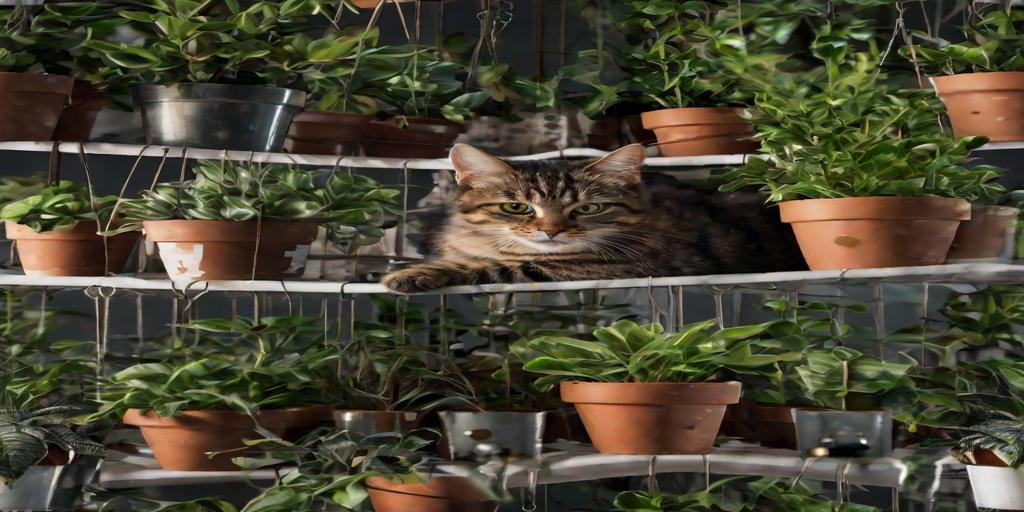
Safe Hanging Plants for Cat Owners Living in Low Light Spaces
Discover the best safe hanging plants for cat owners that thrive in low light spaces! Keep your feline friends happy and your home green with these non-toxic, easy-care plant picks.
Introduction
Did you know that over 30% of pet poisonings are caused by common houseplants? If you’re a cat owner with a love for greenery but limited sunlight, finding the perfect hanging plants can be tricky. You want something pet-safe, low-maintenance, and shade-tolerant—luckily, we’ve got you covered! Whether you’re a seasoned plant parent or a newbie, this guide will help you create a lush, cat-friendly oasis without the worry. Let’s dive in!
Why Choose Cat-Safe Hanging Plants?
The Dangers of Toxic Plants for Cats
Many common houseplants can be harmful—or even deadly—to cats. Lilies, pothos, and philodendrons, for example, can cause symptoms like vomiting, diarrhea, drooling, or even kidney failure if ingested. Cats are naturally curious and may nibble on leaves, so it’s crucial to choose plants that won’t put them at risk. If you notice your cat acting lethargic, pawing at their mouth, or showing signs of distress after being near a plant, contact your vet immediately.
Benefits of Hanging Plants for Pet Owners
One of the easiest ways to keep plants and pets separate is by hanging them out of reach. High shelves and ceiling hooks allow you to enjoy greenery without worrying about your cat turning it into a snack—or knocking it over. Plus, hanging plants add a beautiful vertical element to your space, making rooms feel more dynamic.
How Low-Light Plants Simplify Indoor Gardening
Not every home gets bright, direct sunlight—and that’s okay! Low-light plants are forgiving and adaptable, thriving in indirect light or even artificial lighting. This makes them perfect for apartments, offices, or rooms with few windows. They also tend to require less maintenance, so you won’t need to constantly adjust their care routine.
Top 5 Safe Hanging Plants for Low Light
Spider Plant (Chlorophytum comosum)
Spider plants are a classic choice for pet owners. They’re non-toxic, incredibly hardy, and produce cascading baby plants (called “spiderettes”) that look stunning in hanging baskets. They thrive in indirect light and can tolerate occasional neglect, making them ideal for beginners.
Boston Fern (Nephrolepis exaltata)
If you love lush, feathery foliage, the Boston fern is a fantastic pick. Safe for cats, this plant thrives in humid environments, making it great for bathrooms or kitchens. Just keep the soil consistently moist (but not soggy) and mist the leaves occasionally to maintain humidity.
Peperomia (Peperomia spp.)
Peperomias come in a variety of colors and textures, from deep green ripple varieties to watermelon-striped leaves. They’re compact, low-maintenance, and perfectly safe for curious cats. Since they store water in their leaves, they’re forgiving if you forget to water them now and then.
Staghorn Fern (Platycerium spp.)
For something truly unique, try a staghorn fern. These epiphytic plants grow on mounts rather than in soil, giving them a striking, sculptural look. They’re safe for pets and thrive in bright, indirect light with occasional misting.
Parlor Palm (Chamaedorea elegans)
Elegant and airy, the parlor palm adds a tropical touch to any space. It’s non-toxic, thrives in low light, and grows slowly, so it won’t outgrow its hanging spot too quickly. Just keep it away from cold drafts, and it’ll reward you with lush, graceful fronds.
Care Tips for Low-Light Hanging Plants
Best Watering Practices to Prevent Root Rot
Overwatering is the biggest killer of indoor plants, especially in low-light conditions where soil takes longer to dry. Always check the top inch of soil—if it’s dry, it’s time to water. If it’s still damp, wait a few more days. Ensure your pots have drainage holes to prevent soggy roots.
Ideal Placement for Optimal Growth
While these plants tolerate low light, they still need some indirect brightness to thrive. Avoid dark corners entirely—instead, place them near north-facing windows or a few feet away from brighter light sources. Keep them away from heating vents or drafty areas, which can stress the plants.
How to Fertilize Safely Without Harming Pets
Use organic, pet-safe fertilizers (like worm castings or diluted fish emulsion) to nourish your plants without risking chemical exposure to your cat. Avoid synthetic fertilizers that could be toxic if ingested. Apply fertilizer sparingly—low-light plants grow slowly and don’t need frequent feeding.
Styling Your Hanging Plants in Small Spaces
Creative Hanging Solutions
Macramé hangers add bohemian charm, while ceiling hooks keep plants secure in high-traffic areas. For renters, adhesive hooks or wall-mounted shelves can be a great non-permanent option. If you’re tight on space, try a tiered plant hanger to display multiple plants in one spot.
Pairing Plants for Visual Interest
Mix textures and colors for a dynamic look—pair the trailing vines of a spider plant with the upright fronds of a parlor palm, or contrast the glossy leaves of a peperomia with the soft fronds of a Boston fern. Variegated plants (like certain peperomias) add pops of color even in low light.
Maximizing Vertical Space in Apartments
Hanging plants free up valuable surface area, making them perfect for small homes. Use wall-mounted planters, floating shelves, or even a tall ladder shelf to create a green “wall” without sacrificing floor space.
Common Mistakes to Avoid
Overwatering vs. Underwatering in Low-Light Conditions
It’s easy to assume your plant needs water just because the soil looks dry on top, but low-light plants use water more slowly. Always check deeper into the pot before watering. On the flip side, don’t let them dry out completely—consistent moisture is key.
Choosing Decorative but Unsafe Planters
Some planters may contain lead-based glazes or toxic materials that can leach into the soil. Stick to untreated ceramic, terracotta, or food-safe plastics. Also, avoid heavy pots that could fall if your cat bumps into them.
Ignoring Signs of Plant Stress or Feline Curiosity
If your plant’s leaves are yellowing or drooping, adjust its care before it’s too late. Similarly, if your cat keeps trying to reach a hanging plant, consider moving it higher or adding a deterrent (like double-sided tape on the shelf below). Prevention is easier than dealing with a chewed-up fern—or a sick kitty!
Conclusion
Creating a cat-friendly, low-light jungle is easier than you think! With the right safe hanging plants, you can enjoy lush greenery without compromising your pet’s health. Remember: Spider Plants, Boston Ferns, and Peperomias are fantastic choices for beginners. Ready to transform your space? Start with one or two plants and watch your home—and your cat—thrive!
